ADC circuits that resolve signal into 20 or more bits need a low-noise signal source for measuring parameters such as harmonic distortion or effective number of bits. A notch filter removes the fundamental frequency from the oscillators signal for testing harmonic distortion.
A low-distortion oscillator is necessary for testing today’s ADCs (analog-to-digital converters) that have resolution higher than 20 bits. Low-distortion amplifiers with THD (total-harmonic distortion) of –120 dB or less also need such an oscillator for testing. Commercially available distortion meters offer many measurement functions, but even the best have a THD measurement limit somewhere around –115 dB (Ref 1). Several low-distortion oscillator designs have been published, but they have also have THD of –120 dB or slightly better (Refs. 2, 3, 4). At JanasCard, we’ve developed an oscillator with THD below –140 dB that we use for in-house testing.
The oscillator in Figure 1 uses an inverted Wien-bridge topology with amplitude stabilization through an LED-driven CdS (cadmium-sulfide) photocell isolator. IC1 and IC2 are low noise, high linearity LME49710 audio amplifiers from Texas Instruments, key components of the oscillator. These amplifiers have nonlinearity below 0.1 ppm in inverting mode (Ref. 5). IC1 acts as an inverter with gain –1. IC2, in conjunction with R1, R2, R3, R4, C1, C2, and C3, forms a band-pass filter that sets the oscillator’s resonant frequency to 2 kHz. The design uses a Wien bridge with values R, C, R/2, and 2C because it the oscillator needs an inverting gain of –1.
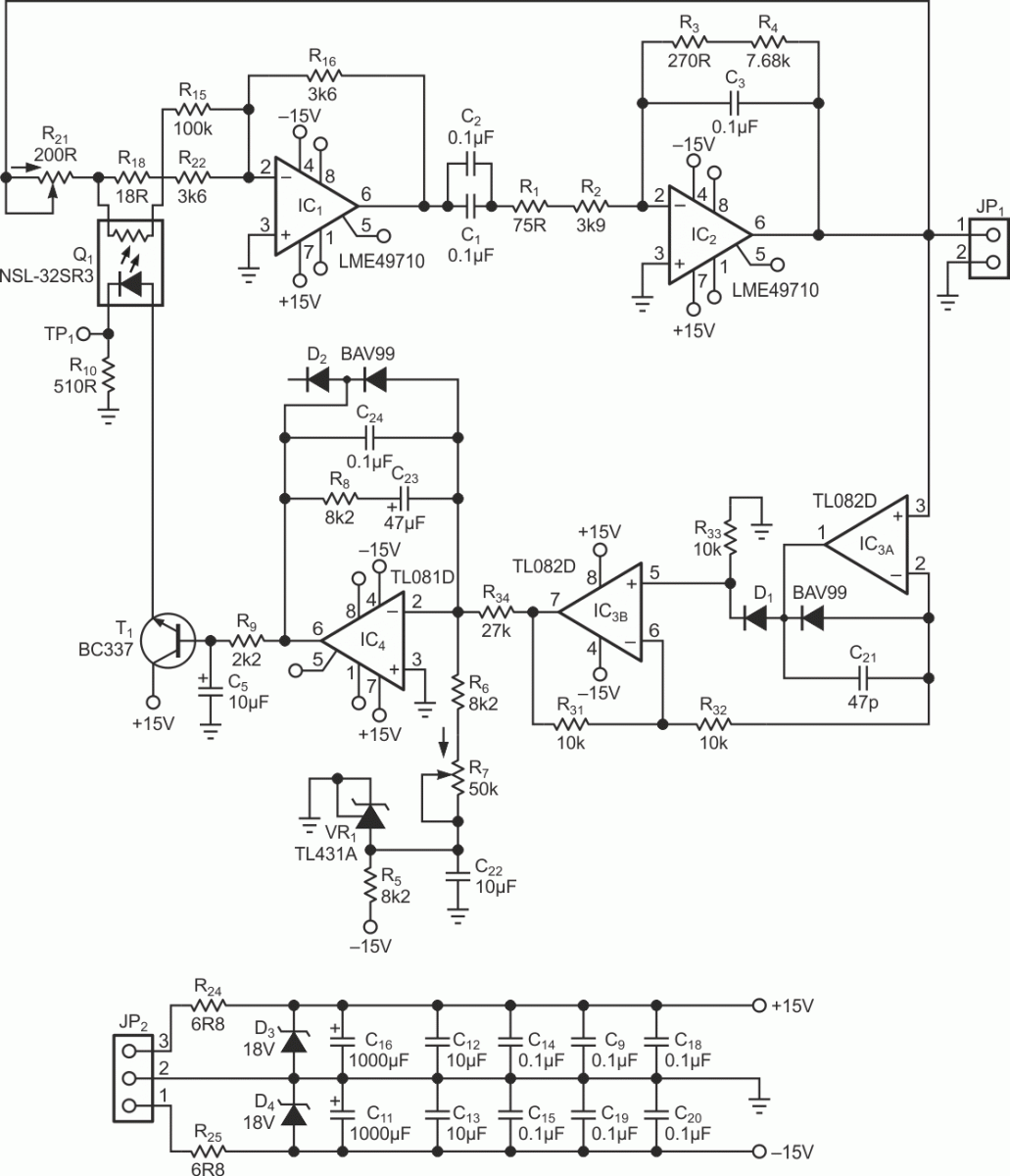 |
|
| Figure 1 | Ultra low distortion oscillator. |
You can use a simpler configuration with equal values for R and C, (Ref. 4) but it requires an inverter with a gain of –2 and you must take the output from the inverting amplifier stage. The resulting noise is significantly higher because of the higher overall gain and the circuit isn’t bandwidth limiting.
Noise is also an important parameter for ADC testing. Thus, we used SPICE simulation on the oscillator’s noise performance. Figure 2 shows that the circuit’s voltage noise-spectral density is highest at the resonant frequency and then falls at higher frequencies because of band-pass filtering. Total noise in the 20 Hz-30 kHz band is 1.7 µV. That gives a theoretical SNR (signal-to-noise ratio) of 126 dB for output level 10 VPP, or 3.5 VRMS. The LM49710 has voltage-noise density of 2.5 nV/√Hz. Resistors and input noise currents of the amplifiers also add to the overall noise. If the lowest possible noise is important, you can use lower resistor values, but that’s at the expense of higher power consumption and increased distortion. The LM49710 distortion performance is specified with minimum load resistance of 600 Ω.
 |
|
| Figure 2 | Noise simulation. |
For amplitude stabilization, the oscillator’s AGC (automatic gain control) circuit consists of a fullwave rectifier with high input impedance (IC3A, IC3B), integrator IC4, and optocoupler O1. The voltage across the optocoupler’s photo-resistor is only 18 mV as set by the 18-Ω parallel resistor R18. That voltage keeps the voltage across O1 to a negligible level. Multiturn trim poteniometer R21 sets the AGC’s working point to roughly 10 mA through O1's LED (5 V at TP1). Turn R21 slowly until the AGC locks, loop’s time constant is several seconds. The setting is quite sensitive because of the AGC loop’s narrow range. After setting the proper operating point with R21, set the output amplitude with multiturn trim potentiometer R7 in range of 5 VPP to 10 VPP.
Right selection of passive components in signal chain is another important requirement for minimum distortion. Resistors are preferably 0.1%, 15 ppm/K through-hole types, capacitors are preferably polystyrene foil types, second best choice are NP0 (Negative Positive Zero) with their smaller size and lower temperature coefficients, but slightly higher distortion (Ref. 6).
Performance verification
We know of no commercially available equipment with enough resolution to directly measure distortion of the ADC circuit. Fortunately, you can use a simple two-stage approach. First, attenuate the fundamental frequency as much as possible; at least 80 dB. A low-distortion notch filter lets you measure residual distortion much more simply than a spectrum analyzer. Figure 3 shows a tunable notch filter with an amplifier. The notch filter is a passive twin-T circuit, which rejects the oscillator’s fundamental frequency, but it also attenuates the second and third harmonics by about 9 dB and 5 dB, respectively.
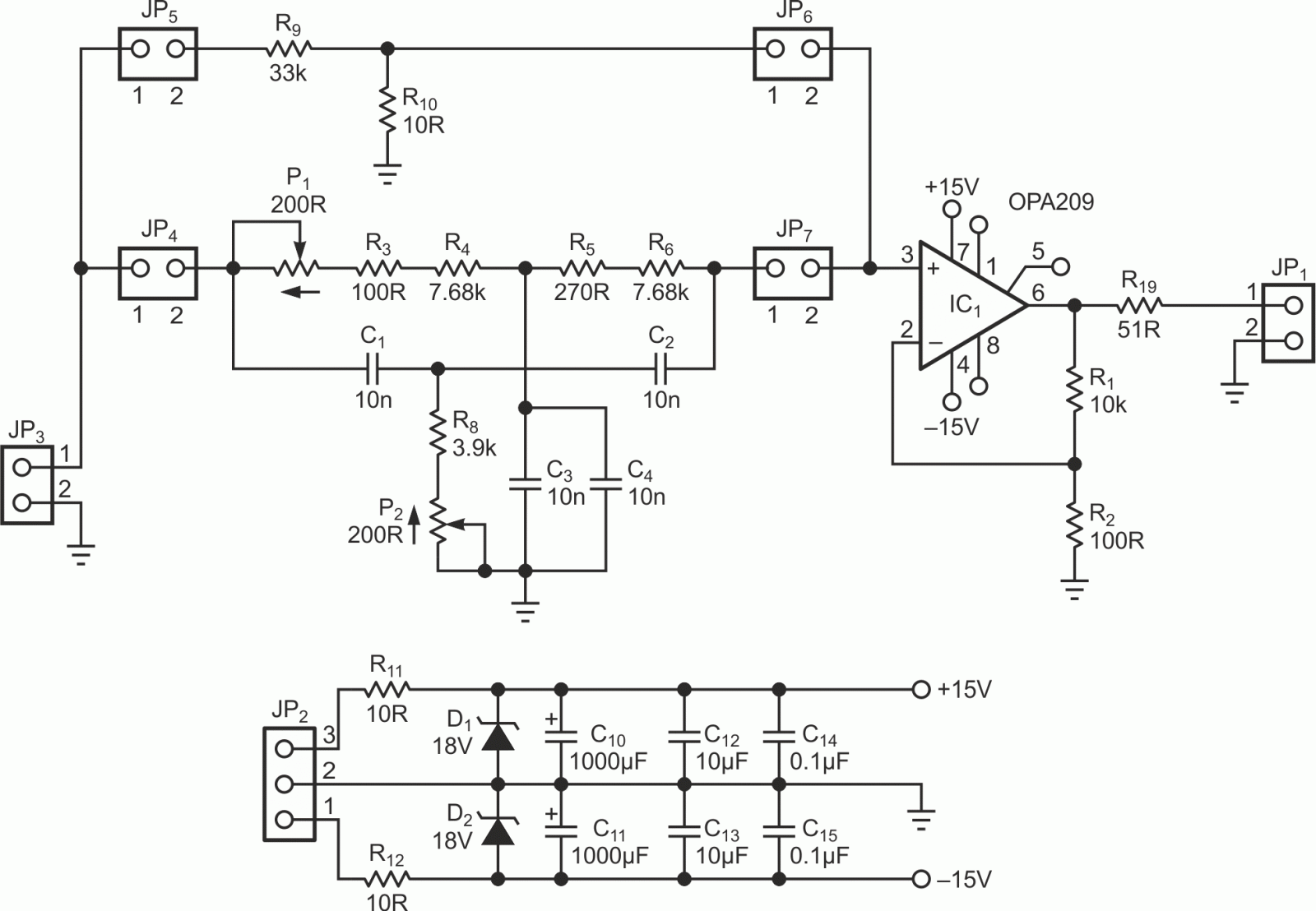 |
|
| Figure 3 | Twin T notch and amplifier. |
Distortion performance of the notch filter is important, so use the same high quality passive components as in the oscillator. Feed the notch-filter’s output into low-noise amplifier IC1 with a gain of 100. Monitor the output of this amplifier with any common spectrum analyzer or with a PC sound card and frequency-analysis software. For quick self-testing of distortion and gain accuracy of the whole measurement chain, the circuit has a jumper-selectable resistive divider (R9, R10) with 70 dB attenuation.
Figure 4 shows the noise and distortion performance of the amplifier and analyzer together when the attenuator is connected to the output of the oscillator. We used our DAQ module AD14ETH www.janascard.cz as a spectrum analyzer. The DAQ module has a 14-bit ADC with 400 ksamples/s sample rate. The module averages 8 samples to reduce sampling speed to 50 kS/s and takes 128 ksamples to perform FFT analysis. The high number of samples is necessary for highest possible dynamic range, second harmonic is as low as –150 dBV so frequency resolution bellow 1 Hz is necessary. Fig. 4 shows that noise floor of the amplifier is –155 dBV. The third harmonic is –141 dBV, so the amplifier’s THD together with that of DAQ module is less than 80 dB.
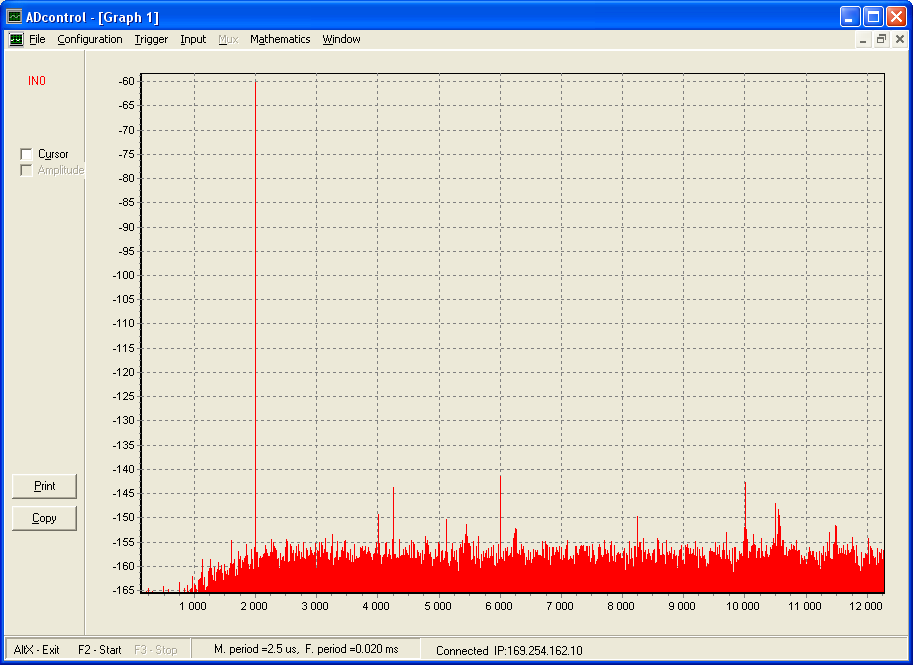 |
|
| Figure 4 | Noise and distortion of the amplifier. |
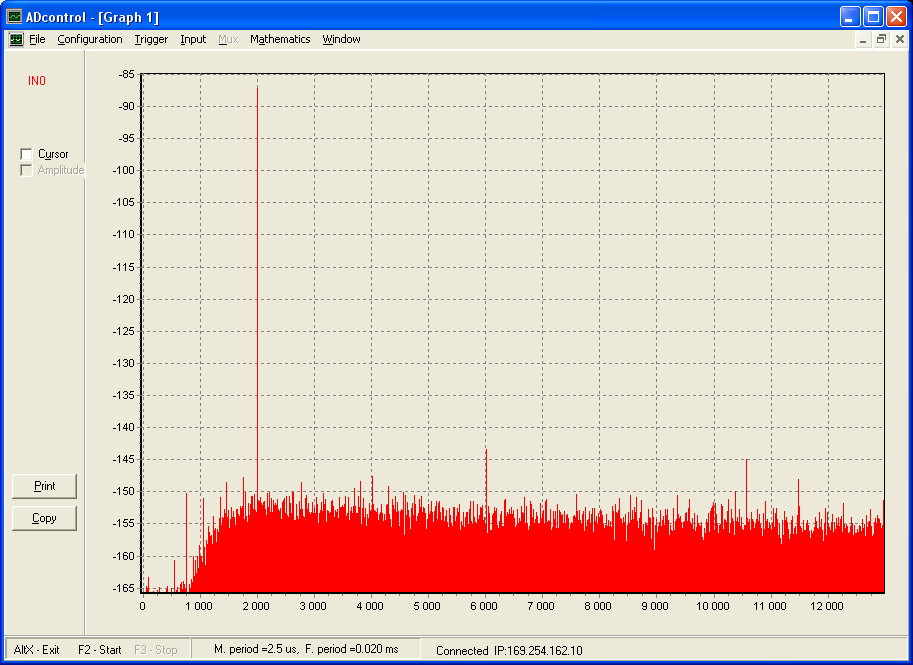 |
|
| Figure 5 | Distortion with NP0 capacitors. |
After verifying that JP5, JP6 are open and JP4 and JP7 are closed, connect an AC voltmeter or oscilloscope to the output and tune P1 and P2 for maximum attenuation of the oscillator’s fundamental frequency. Now the filter is ready to measure the oscillator’s THD. Figure 5 shows distortion of the oscillator with NP0 capacitors, the second harmonic is –147 dBV, the third harmonic is –143 dBV, oscillator output level is +10 dBV. Thus, the second harmonic is 10 dB + 147 dB –9 dB = 148 dB below the fundamental. The third harmonic is 10 dB + 143 dB –5 dB = 148 dB below the fundamental. THD is –145 dB. Figure 6 shows distortion with C3 replaced with a polystyrene foil capacitor. Distortion is several dB lower. The second harmonic is –151 dB, which is nearly invisible in the noise. The third harmonic is also –151 dB below the fundamental. THD is –148 dB.
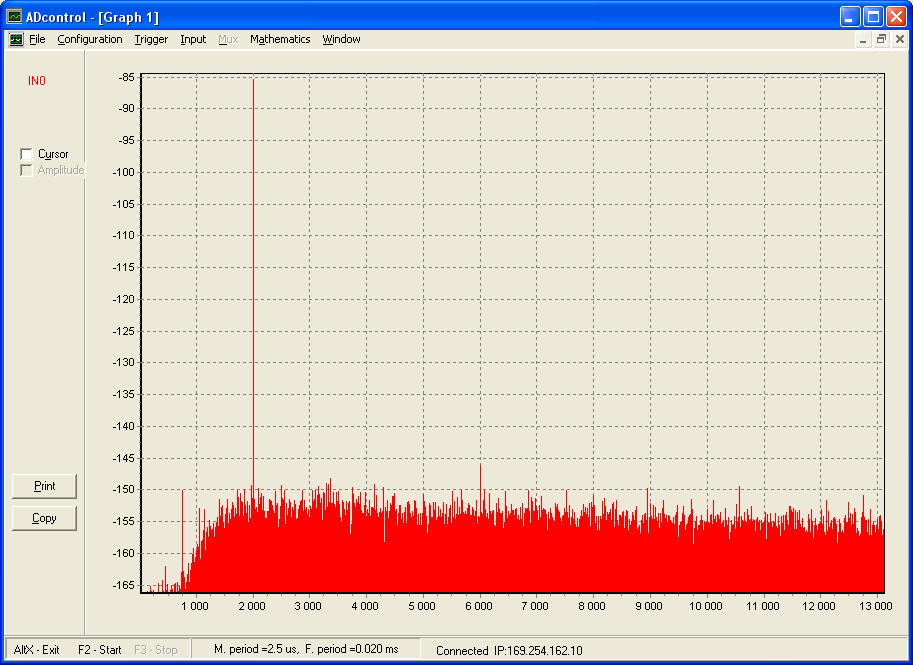 |
|
| Figure 6 | Distortion with polystyrene foil capacitor. |
When lower performance is acceptable, significantly simplified version of oscillator can be used.
The oscillator in Figure 7 is a standard noniverting Wien bridge with gain +2 around IC1 and integrator IC2, active rectifier is replaced by dual diode D5, second half act as a temperature compensation. This simplified version has THD –120 dB and higher noise than the first circuit due higher noise gain of the circuit and no bandpass filtering but it still outperforms many at least 100x more expensive equipments.
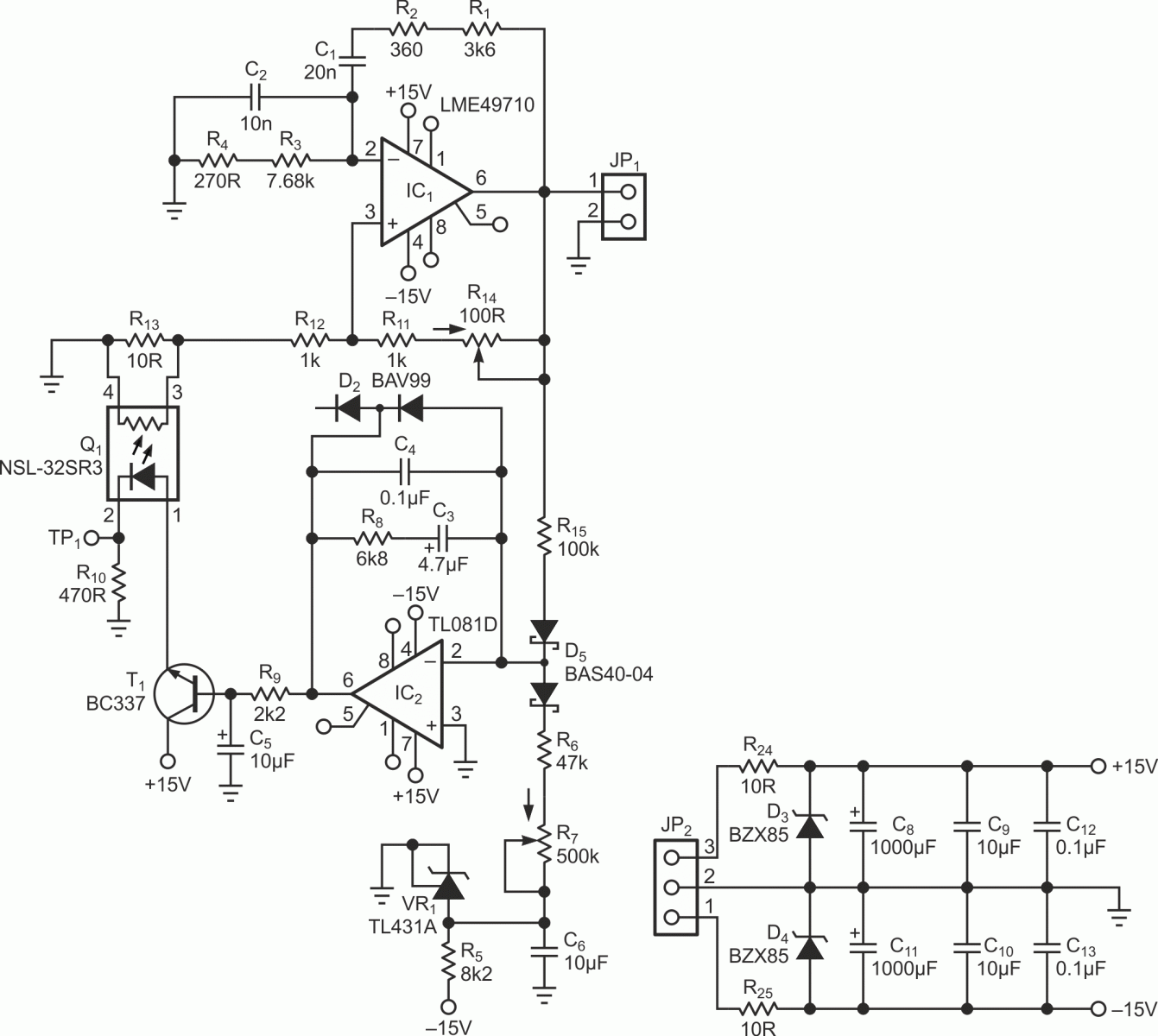 |
|
| Figure 7 | A simple Wien oscillator. |
References
- Audio Precision analyzer series 2700.
- Smith, Jeff, “Oscillator keeps THD below 1 ppm,” EDN Design Ideas, November 10, 1994.
- Eagar Dale, “Using Super Op Amps to Push Technological Frontiers: an Ultra-Pure Oscillator”
- Williams, Jim and Guy Hoover, “Test 18-bit ADCs with an ultrapure sine-wave oscillator,” EDN, August 11, 2011.
- Pease, Robert A.,”Gain and Linearity Testing for Precision Operational Amplifiers.”
- Bateman, C.,”Capacitor Sounds 1 - Low Distortion (sub 1PPM ) 1 kHz Test Oscillator”
Materials on the topic
- Datasheet National Semiconductor LME49710
- Datasheet Texas Instruments OPA209
- Datasheet Texas Instruments TL081
- Datasheet Texas Instruments TL082
- Datasheet ON Semiconductor TL431A
- Datasheet Silonex NSL-32SR3S
- Datasheet Taiwan Semiconductor BAS40
- Datasheet Nexperia BAV99
- Datasheet ON Semiconductor BC337